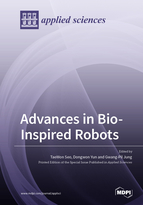Advances in Bio-Inspired Robots
A special issue of Applied Sciences (ISSN 2076-3417). This special issue belongs to the section "Robotics and Automation".
Deadline for manuscript submissions: closed (31 May 2021) | Viewed by 26426
Special Issue Editors
Interests: service robot design and control
Special Issues, Collections and Topics in MDPI journals
Interests: bio-mimetic robot; robot design and control; industrial robot; military robot; mechatronics system
Special Issue Information
Dear Colleagues,
Bio-inspiration can be a good starting point to design a robotic system, controllers, sensors, and a learning algorithm. Observations of animals and plants can lead to new ideas that humans have not thought of. Making good use of these ideas can help researchers to create more creative and efficient robots. For this reason, research on developing robots by mimicking the shape and motion of animals and plants has been conducted. If these bio-inspiration techniques are used well, they can provide clues to overcome the limitations of conventional robots. Bio-inspiration is also in the spotlight for its potential use in robots for military and environmental monitoring because bio-inspired robots have excellent cover characteristics by copying the shape and movement of animals in nature. The efficient movement of animals is also a key design reference for the development of highly efficient robots. This Special Issue is designed to provide an opportunity to introduce and share state-of-the-art research in the field of bio-inspired robots by collecting and introducing recent research results of various bio-inspired robots. We look forward to the participation of researchers who are conducting research in this field.
Prof. Dr. TaeWon Seo
Prof. Dr. Dongwon Yun
Prof. Dr. Gwang-Pil Jung
Guest Editors
Manuscript Submission Information
Manuscripts should be submitted online at www.mdpi.com by registering and logging in to this website. Once you are registered, click here to go to the submission form. Manuscripts can be submitted until the deadline. All submissions that pass pre-check are peer-reviewed. Accepted papers will be published continuously in the journal (as soon as accepted) and will be listed together on the special issue website. Research articles, review articles as well as short communications are invited. For planned papers, a title and short abstract (about 100 words) can be sent to the Editorial Office for announcement on this website.
Submitted manuscripts should not have been published previously, nor be under consideration for publication elsewhere (except conference proceedings papers). All manuscripts are thoroughly refereed through a single-blind peer-review process. A guide for authors and other relevant information for submission of manuscripts is available on the Instructions for Authors page. Applied Sciences is an international peer-reviewed open access semimonthly journal published by MDPI.
Please visit the Instructions for Authors page before submitting a manuscript. The Article Processing Charge (APC) for publication in this open access journal is 2400 CHF (Swiss Francs). Submitted papers should be well formatted and use good English. Authors may use MDPI's English editing service prior to publication or during author revisions.
Keywords
- bio-inspired robotics
- bio-inspired design
- bio-mimetic
- bio-inspired motor control
- bio-inspired leaning
- bio-inspired sensing system
- origami robots
- soft robotics
- bio-inspired robotic applications








